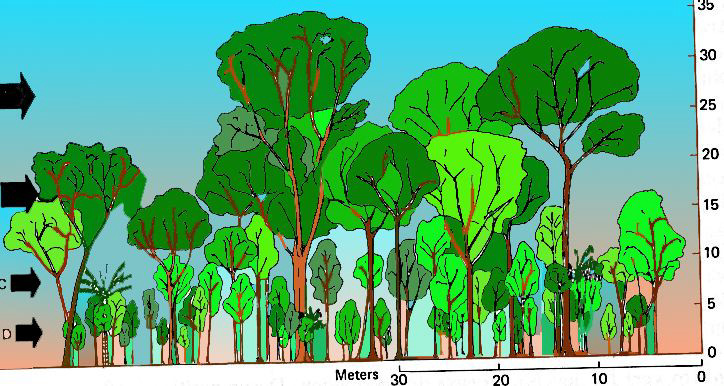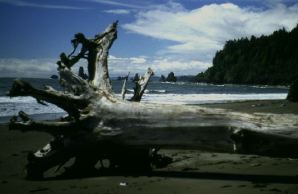by Joseph Siry
Forests and civilization | Antilles forests | forests as sources | simulation problem | Forest disturbance | 1994 warning | value of | Forests and rivers.
![]()
through too many obstructing trees, at the forestry summit"
by Joseph Siry
Forests and civilization | Antilles forests | forests as sources | simulation problem | Forest disturbance | 1994 warning | value of | Forests and rivers.
![]()
Forests are wealth; natural wealth providing the foundation of the housing, furniture and pharmaceutical industries in addition to the timber industry. Like any form of wealth, forests require investment of time and skill, stewardship, and forbearance if they are to prosper, increasing in value over time. All forms of wealth demand capital preservation to increase their worth over time.
Planting new trees is the tangible source of logging jobs for the people who need work they can rely on. Some cancer patients require the taxol drug made from the bark of yew trees that grow mostly in old-growth forests. Forests a form of land-use that can act as carbon storage facilities –especially fast growing trees–that remove carbon dioxide from the air.
Wildlife also needs territory if animals are to reproduce. In some cases a species, such as the spotted owl, requires old-growth forests. These forests too provide cover and shade which is important for river fisheries, such as salmon, that must have cold, clear water to reproduce. For these economic interests to be balanced with recreational and wildlife protection values today's timber management requires long-term vision as it always has.
Any forest is like a savings
account in that it earns interest at an accumulating rate. Like a bank account
forests and other natural features require deposits if you anticipate a withdrawal
without losing the account’s earning power. The lumber that comes from forests
of 80 to 180 year old trees is of higher quality than the timber of recently
planted and younger forests.
From
the old English and German words for forest -- weald and wald, comes our word wealth. The test
of our economic intelligence is the recognition that in the national forests
of the Pacific Northwest the regional economy's health is heavily dependent
on the extent of the old-growth forests. No where else is it so painfully obvious
that good ecology makes for prudent economics. The facts are that cutting the
old-growth forests means no growth for the timber industry in the future, while
protecting the remaining ancient forests will assure the long-term stability
of the logging and fisheries for generations.
The tallest trees reveal clues to the longest prevailing conditions in a forest and when the stands are diverse, the older, taller and more prominent, canopy may provide shade for the low-light tolerant species in the understory. Birds and insects in particular may partition or divide up the food and nesting sources provided by a forest by restricting themselves to the understory, the mid-level, or the canopy of older forests. By holding the soil for rain water to percolate slowly into the ground, the roots of older trees also store a good amount of carbon, as do the trunk and limbs of large trees. The shade reduces temperature swings and may have an appreciable influence on keeping streams cooler in the summer months, thereby moderating the conditions that fish are used to upstream.
Geographers and botanists argue that "Most of the old-growth forest has been cut. Only
about 17% of the original old-growth Douglas fir forest of the Pacific Northwest
remains, the bulk of this being in United States National Forests." Seven species
other than the northern spotted owl exist on these public lands because the
conditions of the old-growth forests nourish their otherwise endangered existence.  The
owls represent the value of the oldest trees and rarest timber in their habitat.
The courts currently preserve approximately $4 billion dollars worth of forests
from logging. Currently federal forestry policy allows the sale of grazing,
mining, and timber leases at below market value of the resources in question.
In this respect existing timber leases are subsidies to lumber companies and
discounts the timber resources since the purchase price of the lease is less
than the cost of maintaining the forest!
The
owls represent the value of the oldest trees and rarest timber in their habitat.
The courts currently preserve approximately $4 billion dollars worth of forests
from logging. Currently federal forestry policy allows the sale of grazing,
mining, and timber leases at below market value of the resources in question.
In this respect existing timber leases are subsidies to lumber companies and
discounts the timber resources since the purchase price of the lease is less
than the cost of maintaining the forest!
Because of the old growth forests' importance President Clinton, in 1996, ordered a 60 day deadline for six governmental agencies to cooperate with one another and their Pacific Northwest constituents to equitably plan for the future of both people who need jobs and wildlife that depend on these forests.
 Once the forests
are gone good land management requires the investment of time and jobs to restore
the capacity of the land to grow new trees. After all, as one logging woman
suggested at the summit, "Forests are a renewable resource." Yet in some regions
that renewable resource has been squandered for short-term gain.
Once the forests
are gone good land management requires the investment of time and jobs to restore
the capacity of the land to grow new trees. After all, as one logging woman
suggested at the summit, "Forests are a renewable resource." Yet in some regions
that renewable resource has been squandered for short-term gain.
In southern Washington on Wilapa Bay, oyster farming has replaced lumber milling because of too much clear cutting by the timber industry. The old-growth forests protect the streams for salmon to spawn in northern California, Oregon and Washington. The fishing industry supports approximately 60,000 jobs in the region. When too many trees are cut at a rate beyond the capacity of new trees to grow, the forests are over harvested, and not just the loggers, but everyone suffers. So to see a forest as only as a series of trees to cut for timber is to lose sight of the ecosystem services and renewable sources of wealth that forests provide in protection our wildlife and watersheds.
- 2 pages -
918 words
Forests and civilization | Antilles forests | forests as sources | simulation problem | Forest disturbance | 1994 warning | value of | Forests and rivers.
Japanese Government
White Paper on the environment for 1994 warns about forestry declines.
Pursuant to the Basic Environmental Law of Japan.
November of 1993.
The world's forested areas are decreasing. Over the 15-year period from 1974 to 1989, although there was almost no change in the area covered by forest land in developed countries, forested areas in developing countries declined 6.8%. According to the FAO's Forestry Resources Evaluation, there was an especially large decline in tropical forests, which shrank at an average annual rate of 154,000 square kilometers from 1981 to 1990.
Future estimates of forestry products:
This also implies that information regarding future markets and prices for both roundwood and forest products be integrated into the supply analysis. In many cases, this linkage is not explicit in supply forecasts. Supply response to future economic conditions and prices can significantly alter supply flow conditions. Supply quantities at 2010, for example, will be as much determined by responses to anticipated prices and returns from forest management as by simple biological productions.
Related discussions of forests:
National Forests and Parks are often unhappy neighbors
The Olympic National Forest surrounds the Olympic National Park:
You are a member of a technical advisory committee
Lessons from a walk in the woods
Ancient word for forests reveals their wealth
Forests and civilization | Antilles forests | forests as sources | simulation problem | Forest disturbance | 1994 warning | value of | Forests and rivers.

|
|
|
![]()